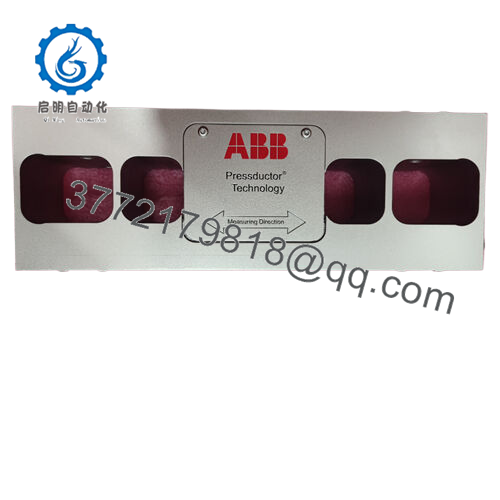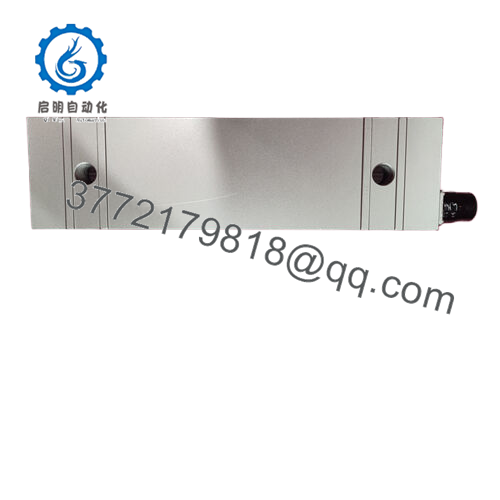Description
In the relentless pulse of industrial automation, where precise tension control in continuous web processes can make or break output quality, the oversight of force variations often spirals into material snarls, uneven coatings, or outright breaks—picture a paper machine where undetected web slack leads to sheet tears and mill downtime, or a metal strip line where inconsistent pulls warp profiles and spike scrap rates, eroding margins in environments where every gram of force ties to throughput and safety. These imbalances hit hardest in high-speed lines, where vibrations, humidity, or thermal shifts amplify drift, demanding sensors that deliver unyielding accuracy without the drag of frequent recalibrations or mechanical overhauls. This is the challenge the ABB PFTL101B 2.0KN 3BSE004185R1 meets head-on as a Pressductor PillowBlock load cell, leveraging magnetoelastic sensing to capture horizontal forces with the stability to anchor process control loops, ensuring your lines run taut and true amid the grind of 24/7 demands.
Operators scaling tension systems in legacy or hybrid DCS setups frequently battle transducers that succumb to overloads or crosstalk in shared cabinets, yielding erratic I/O signals that fragment diagnostics and invite false alarms in safety-rated zones. The ABB PFTL101B 2.0KN 3BSE004185R1 becomes a necessity here, rated for 2.0 kN nominal loads in horizontal measurements, where its robust housing integrates seamlessly with ABB’s 800xA platforms to feed clean 4-20 mA outputs for real-time monitoring in applications like winders or coaters. It’s crucial for sectors such as pulp and paper or flexible packaging, where high-reliability force detection underpins compliance with ISO standards, staving off the cascade of defects from tension spikes that could halt production for hours. Lacking this level of precision, you’d contend with strain-gauge alternatives prone to hysteresis or custom amplifiers, diverting teams from yield optimization to endless zeroing in the face of environmental flux.

PFTL101B 2.0KN 3BSE004185R1
Within the broader shift toward predictive web handling in industrial automation, the call grows for load cells that embed overload protection without compromising footprint or signal purity. The ABB PFTL101B 2.0KN 3BSE004185R1 excels through its Pressductor core, which harnesses the magnetoelastic effect—where applied force alters magnetic permeability for drift-free readings up to 150% of capacity—while the PillowBlock design mounts effortlessly for edge-of-web placements. This sensor isn’t just a measurer; it’s the vigilant gauge that transmutes mechanical stress into actionable data, letting your engineers forecast wear from trend variances rather than reacting to ruptures in SCADA feeds. In regulated landscapes like food converting or nonwovens, where tension uniformity governs product specs, it fortifies I/O signal integrity that scales with IIoT layers, building a foundation for resilient, data-led operations.
| Specification | Details |
|---|---|
| Model Number | 3BSE004185R1 |
| Brand | ABB |
| Type | Pressductor PillowBlock Load Cell |
| Input Voltage | 10-30 V DC |
| Operating Temp Range | -30°C to +80°C |
| Mounting Style | PillowBlock (Flange) |
| Dimensions | 200 x 100 x 50 mm |
| Weight | 2.0 kg |
| Interface/Bus | 4-20 mA Analog |
| Compliance | CE, RoHS |
| Supported Protocols | HART Optional |
| Typical Power Draw | 0.5 W |
The ABB PFTL101B 2.0KN 3BSE004185R1 functions as the tactile sentinel in your tension architecture, mounted at idler roll bearings to detect horizontal web forces via its magnetoelastic core, which modulates an excitation coil’s reluctance to output a proportional current signal—integrate it into S800 I/O racks or DCS gateways for low-latency polling, where it positions as an edge transducer feeding PID controllers for closed-loop adjustments. This setup thrives in distributed systems, conditioning signals with built-in amplification to reject common-mode noise up to 50 V/m, ensuring clean transmission over 300m runs without repeaters, much like a steadfast whisperer converting pull into pulses for upstream logic solvers.
In practical deployments, its synergy shines: the PillowBlock encases the sensor in a sealed aluminum housing for IP65 resilience, with adjustable flanges that align to shaft diameters from 20-50 mm, while overload stops cap excursions at 300% to avert core saturation. Wire via M12 connectors for shielded cabling, and diagnostics—such as zero-drift checks or integrity flags—route to asset tools over HART for remote calibration, streamlining tweaks in multi-roll setups. For redundancy, pair it in duplex mounts to mirror readings, sustaining feeds during roll changes without loop breaks. Upstream, it populates force variables in your HMI for operator dashboards; downstream, it drives actuator tweaks in tension zones, all configured through standard engineering software that bypasses proprietary tweaks. As lines expand, the ABB PFTL101B 2.0KN 3BSE004185R1 chains via analog multiplexers, hot-swappable to boost channel density without halting webs, weaving legacy Pressductor ties into modern fieldbus evolutions for agile, noise-immune process control.
Selecting the ABB PFTL101B 2.0KN 3BSE004185R1 equips your web lines with force acuity that tames the whims of material variance, especially in spans where slack could otherwise unravel edges and compound edge cracks. In the flow of high-volume runs, this yields profile consistency that holds—tensions track setpoints sans wander, refining caliper uniformity in coaters and curbing the rejects from flutter that plague drift-prone cells, delivering measurable uptime lifts and leaner waste streams for your shift supervisors.
The sensor’s magnetoelastic heart further liberates upkeep, with inherent non-linearity below 0.1% that weathers humidity cycles without seasonal spans, sparing the enclosure seals that burden foil alternatives in steamy mills and locking in performance steadiness through speed surges. Crews draw from its signal purity to preempt faults, often isolating roll imbalances before they bias batches, which sharpens interventions and extends calibration cadences in the mix. Engineered for the ceaseless draw of continuous duty, it aligns with lean goals, its low draw easing loop powering in solar-tied sites. And its flange flexibility trims install toil, bolting to extant frames sans shimming, so your retrofits roll out rhythmic.
Deeper, the ABB PFTL101B 2.0KN 3BSE004185R1 sparks scalability: optional HART overlays infuse digital twins for AI tension models, preserving stake as DCS fabrics layer edge analytics. This versatility lightens audit loads, with force histories ratifying ASTM specs sans add-ons. In essence, it’s a pivot for poised pull, where exacting elasticity extracts edges from edge to end, recasting tension tangles into tuned triumphs.
In paper production winders, the ABB PFTL101B 2.0KN 3BSE004185R1 mounts at slitter shafts to gauge rewind tension amid steam and lint, capturing 2.0 kN pulls with vibration immunity for critical system uptime in process control environments where force fidelity forestalls crepe wrinkles—high reliability shines in sustaining reel builds without core collapses.
Foil metallizing lines deploy the ABB PFTL101B 2.0KN 3BSE004185R1 for dancer roll feedback in vacuum chambers, enduring thermal vacuums with sealed poise to drive fast data cycles that hold coat thicknesses—vital for continuous uptime in process control where sensor drift dictates defect densities.
Textile dyeing ranges harness the ABB PFTL101B 2.0KN 3BSE004185R1 to monitor pad rolls in wet sections, braving dye baths with corrosion guards for high reliability in process control environments demanding even draws amid fabric swells, integral to colorfast runs sans streaks.
PFTL101A 1.0KN 3BSE004166R1 – Lower-capacity variant for lighter web tensions in fine-paper setups.
PFTL101B 5.0KN 3BSE004191R1 – Higher-range model for heavier substrates like board stock.
PFTL101AE 2.0KN HIEE300888R0002 – Mill-duty edition with IP66 for dryer section harshness.
PFTL101BE 2.0KN 3BSE004214R1 – Enhanced version for high-vibration calender applications.
PFEA111 3BSE042238R2 – Compact tension transducer for space-limited edge guides.
PFCL201CD 50KN 3BSX802939-108 – Electronics companion for amplified signal processing.
PFTL101B 20KN 3BSE004203R1 – Heavy-duty sibling for metal strip or cable lines.
Before anchoring the ABB PFTL101B 2.0KN 3BSE004185R1 to your roll frame, verify shaft alignment with a dial gauge—misalignments over 0.1 mm skew baselines; ABB’s mounting templates guide this precisely. Assess ambient humidity against the IP65 seal, and slot flanges with 10 mm gaps for thermal expansion, as web heat can nudge housings—insulate if exceeding 60°C. Confirm excitation voltage at 24 VDC with a decade box to zero the output, and torque bolts to 15 Nm for vibration lock. A dry-run deflection test with weights validates linearity, catching core offsets pre-tie-in.
Once woven in, care centers on calibrated consistency. Biweekly, poll the 4-20 mA span for drift—shifts beyond 0.05% cue span checks, resolvable with a shunt calibrator in humid halls to fend off condensation. Quarterly, inspect flanges for play and reseal glands with torque wrenches, key in linty locales where buildup biases mounts. Log force spectra semiannually to trace hysteresis, often from web debris, and align with ISO proofs by loading to 150%. These rhythms, routed to routines, reinforce the cell’s clarity without carving stops, surfacing smarts that steer swaps sagely.


 WhatsApp: +86 16626708626
WhatsApp: +86 16626708626 Email:
Email:  Phone: +86 16626708626
Phone: +86 16626708626


